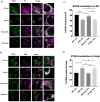Activation of the cGAS-STING innate immune response in cells with deficient mitochondrial topoisomerase TOP1MT
- PMID: 37129502
- PMCID: PMC10360396
- DOI: 10.1093/hmg/ddad062
Activation of the cGAS-STING innate immune response in cells with deficient mitochondrial topoisomerase TOP1MT
Abstract
The recognition that cytosolic mitochondrial DNA (mtDNA) activates cyclic GMP-AMP synthase-stimulator of interferon genes (cGAS-STING) innate immune signaling has unlocked novel disease mechanisms. Here, an uncharacterized variant predicted to affect TOP1MT function, P193L, was discovered in a family with multiple early onset autoimmune diseases, including Systemic Lupus Erythematosus (SLE). Although there was no previous genetic association between TOP1MT and autoimmune disease, the role of TOP1MT as a regulator of mtDNA led us to investigate whether TOP1MT could mediate the release of mtDNA to the cytosol, where it could then activate the cGAS-STING innate immune pathway known to be activated in SLE and other autoimmune diseases. Through analysis of cells with reduced TOP1MT expression, we show that loss of TOP1MT results in release of mtDNA to the cytosol, which activates the cGAS-STING pathway. We also characterized the P193L variant for its ability to rescue several TOP1MT functions when expressed in TOP1MT knockout cells. We show that the P193L variant is not fully functional, as its re-expression at high levels was unable to rescue mitochondrial respiration deficits, and only showed partial rescue for other functions, including repletion of mtDNA replication following depletion, nucleoid size, steady state mtDNA transcripts levels and mitochondrial morphology. Additionally, expression of P193L at endogenous levels was unable to rescue mtDNA release-mediated cGAS-STING signaling. Overall, we report a link between TOP1MT and mtDNA release leading to cGAS-STING activation. Moreover, we show that the P193L variant has partial loss of function that may contribute to autoimmune disease susceptibility via cGAS-STING mediated activation of the innate immune system.
© The Author(s) 2023. Published by Oxford University Press.
Figures








References
-
- Wincup, C. and Radziszewska, A. (2021) Abnormal mitochondrial physiology in the pathogenesis of systemic lupus erythematosus. Rheum. Dis. Clin. N. Am., 47, 427–439. - PubMed
-
- Yang, S.K., Zhang, H.R., Shi, S.P., Zhu, Y.Q., Song, N., Dai, Q., Zhang, W., Gui, M. and Zhang, H. (2020) The role of mitochondria in systemic lupus erythematosus: a glimpse of various Pathogenetic mechanisms. Curr. Med. Chem., 27, 3346–3361. - PubMed
-
- Bursztejn, A.C., Briggs, T.A., del Toro Duany, Y., Anderson, B.H., O'Sullivan, J., Williams, S.G., Bodemer, C., Fraitag, S., Gebhard, F., Leheup, B. et al. (2015) Unusual cutaneous features associated with a heterozygous gain-of-function mutation in IFIH1: overlap between Aicardi-Goutières and singleton-Merten syndromes. Br. J. Dermatol., 173, 1505–1513. - PMC - PubMed
-
- An, J., Briggs, T.A., Dumax-Vorzet, A., Alarcón-Riquelme, M.E., Belot, A., Beresford, M., Bruce, I.N., Carvalho, C., Chaperot, L., Frostegård, J. et al. (2017) Tartrate-resistant acid phosphatase deficiency in the predisposition to systemic lupus erythematosus. Arthritis Rheumatol, 69, 131–142. - PubMed
Publication types
MeSH terms
Substances
Grants and funding
LinkOut - more resources
Full Text Sources
Medical
Molecular Biology Databases
Research Materials

